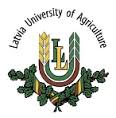Focal point
Location
The Latvia University of Agriculture (LLU) Strategic Development Plan 2010-2016, was developed during 2009 and approved by the LLU Senate on June 10, 2009.
In order to perform its functions and implement its goals and objectives, the Latvia University of Agriculture has developed three activity programs:
1. Studies
2. Science
3. Administrative and financial support for studies and research work
The goal of the Latvia University of Agriculture is to provide the possibility to obtain higher academic and higher professional education in agriculture, veterinary medicine, food technology, engineering, forestry science, social science, information technologies and environment management sectors as well as to develop science and to maintain and develop the Latvian intellectual potential and culture.
The objectives of the LLU:
To ensure the study quality corresponding with the standards of a national university what would allow to educate competitive specialists for the Latvian and international labor markets.
To develop the scientific potential to participate in international research, to integrate the academic education and research what would ensure introduction of innovative, knowledge - based technologies into the Latvian national economy, specially, in the Zemgale region.
To ensure sustainable development for the university as a national education, science and culture institution:
to strengthen the legal basis;
to improve the organizational structure in accordance
to the LLU objectives;to develop cooperation with institutions, academic education and science institutions in Latvia and abroad, enterprises and professional organizations and regional institutions of Zemgale;
to manage the LLU material and technical basis effectively.
The LLU mission
To develop the intellectual potential for sustainable future of Latvia and especially rural areas.
The LLU vision
To become a modern, internationally recognized and prestige university, taking part in the common European academic education and science space.
Members:
Resources
Displaying 6 - 10 of 152Prioritization of land consolidation and exchange works in villages of eastern Poland using example of Frampol commune
Land consolidation and land exchange are two important measures that can be used to improve the spatial structure of farm holdings. Unfortunately, land cannot be consolidated and exchanged in all villages of a given area simultaneously, due to economic, technical, and social considerations. Instead, an analysis has to be carried out, which allows one to rank the villages with regard to how urgently they need consolidation and exchange of land.
Differences in spatial structure of rural areas of commune of Goraj with regard to size of farms owned by natural persons
Agriculture in Poland varies from region to region in terms of the level of farming culture and intensity of production. The majority of holdings are family farms, which use extensive farming practices and which are geared towards multidirectional production. They are characterized by low product marketability. Small farms with an area of 1-5 ha prevail. The largest fragmentation of individual farms is observed in the southern and south-eastern parts of the country. A more favourable agrarian structure is found in northern Poland.
Differences in spatial structure of agricultural areas in Ksiezpol commune with regard to productivity of cropland and grassland
Soil quality is one of the most important factors determining the potential for obtaining a high profit from farming. The agricultural quality of soils is described by soil quality classes, and the suitability of soils for growing particular plants or plant communities is described in terms of soil-agricultural complexes. A unified soil classification has been developed for the entire area of Poland, which takes into account the morphological features and physical properties of Polish soils.
Differences in spatial structure of agricultural areas in villages of commune of Bilgoraj with regard to land fragmentation
The current state of agricultural production space is the outcome of centuries of human activity, as conditioned by socio-economic, legal, and political factors. The characteristic features of the spatial layout of land, which has been shaped in this historical process in the rural areas of southern and south-eastern Poland, are farms divided into a large number of parcels, lack of access to parcels, irregular shapes of parcels, and their scattering in space.
Spatial diversity of agricultural areas with no access to roads in villages of commune of Bilgoraj
Agricultural transport roads play an important role not only from the point of view of individual farm holdings, but also the general development of rural areas. Roads constitute an element of the technical infrastructure indispensable for communication and transport; they play a role in shaping the rural landscape, and the routes they follow affect the forms and size of agricultural land and forest areas found within the area covered by a given road system. The existing public road network does not always provide access to all fields.


